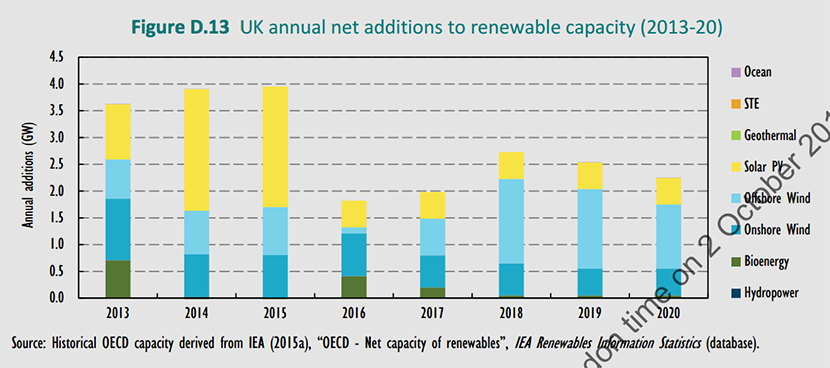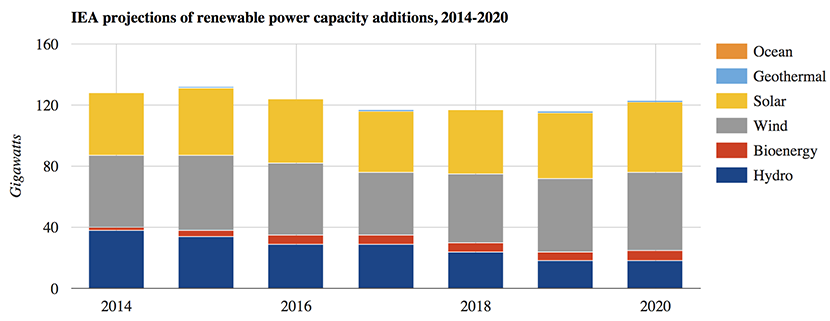IEA scales back UK renewables forecast, citing policy uncertainty
Simon Evans
10.02.15Simon Evans
02.10.2015 | 12:01amThe future for UK renewables is less optimistic than it looked a year ago, according to the International Energy Agency (IEA).
The amount of renewable capacity added in the UK will fall by half between 2015 and 2016, says the IEA’s Medium-Term Renewable Energy Market Report 2015, in part because of uncertainty over government policy following the election in May.
Globally, the IEA expects renewables to be the single largest source of new electricity generating capacity, accounting for nearly two-thirds of all additions to 2020. However, the UK policy environment is not alone in leaving question marks over support for renewables, the IEA warns.
Carbon Brief has a short summary of the report.
UK uncertainty
Since the UK’s general election in May, a series of renewable energy policies have been rolled back or put under review. “Policy uncertainties have emerged,” the IEA says, citing changes to support for onshore wind, solar and other renewables.
Compared to its 2014 outlook, the IEA says its UK forecast for renewables is “less optimistic…with a dip in 2016 due to slower expansion of onshore wind and solar”. This dip will see growth rates fall by more than half, from around 4 gigawatts (GW) added in 2015 to below 2GW in 2016.
Though it expects growth rates to recover, the IEA does not expect annual additions to return to pre-election levels (chart, below).
Past and projected renewable generating capacity additions in the UK between 2013 and 2020. Source: IEA Medium Term Renewable Energy Market Report 2015.
In a foreword to the report, Fatih Birol, IEA executive director, writes:
“Wavering policy commitments…can undermine investor confidence and retroactive changes can destroy it.”
Birol adds that to the contrary, “increased efforts are needed to avoid the destructive impacts of climate change”.
The IEA says that a more rapid deployment of renewables in the UK would require “rapid clarification of future support”, as well as faster cost reductions. But “given current signals from the government”, it says the potential upside towards 2020 is highly uncertain.
The IEA report adds to a growing chorus of concern over the future of UK renewables policy. In recent weeks the Confederation of British Industry, the Committee on Climate Change, accountants EY and former US presidential candidate Al Gore have all expressed doubts.
Despite these concerns, it’s worth noting that the UK has added more than 11GW of renewable capacity over the past three years, with renewables’ share of UK electricity generation reaching 25% in the second quarter of 2015. The IEA expects another 11GW during 2016-2020.
Amber Rudd, secretary of state at the Department for Energy and Climate Change (DECC), is expected to deliver a “reset” speech later this month, where she will set out her vision for the UK’s climate and energy policy. Her focus is likely to remain on limiting the costs of decarbonisation.
Global growth
Globally, the IEA expects renewable power capacity to grow faster than any other source of electricity over the next five years. Around 700GW of renewables will be added by 2020, it says, most of which will be wind and solar. Some 40% of this growth will come from China.
Despite rapidly growing capacity, however, renewables’ share of global electricity generation would reach just 26% in 2020, the IEA says, up from 22% in 2013. This reflects both the overwhelmingly fossil-fuelled nature of current electricity generating infrastructure and the fact that 1GW of wind or solar will generate much less electricity over the course of a year than 1GW of coal or gas.
The IEA expects those 700GW of capacity to be added steadily between now and 2020, with roughly 120GW added each year. It’s worth noting that the IEA doesn’t expect solar capacity growth to accelerate, despite falling prices (yellow bars, below).
Global projected renewable power capacity additions between 2014 and 2020. Source: IEA Medium Term Renewable Energy Market Report 2015. Chart by Carbon Brief.
Some analysts argue the IEA’s renewable energy growth projections are consistently too pessimistic. One detailed study suggests this is because the IEA assumes linear growth rates, whereas renewables have recently grown exponentially.
For example short-term projections from Bloomberg New Energy Finance say nearly 60GW of solar could be added this year, whereas the IEA expects consistent annual additions of 40GW.
The IEA says an accelerated deployment path is possible if government policies, markets and technology become more favourable. In this scenario roughly 175GW of additional capacity would be added — mainly solar and onshore wind — raising the 700GW expected by 2020 by 25%.
Birol writes:
“Renewables are poised to seize the crucial top spot in global power supply growth, but this is hardly time for complacency. Governments must remove the question marks over renewables if these technologies are to achieve their full potential, and put our energy system on a more secure, sustainable path.”
The IEA’s report contains some cause for optimism for renewables. It says dramatic declines in the costs of renewables and signs that emissions could be decoupling from economic growth are changing the nature of negotiations over how to deal with climate change.
Yet in common with most other technologies and policy areas, the IEA says progress on renewables remains well short of what is needed to avoid dangerous climate change.
Image: Wood pellets for biomass. Credit: tchara/Shutterstock.com.
-
The future for UK #renewables is less optimistic than it looked a year ago, according to new @IEA report




